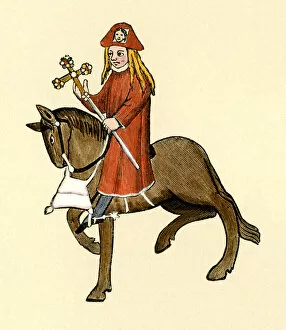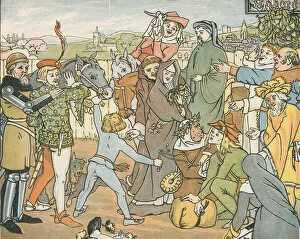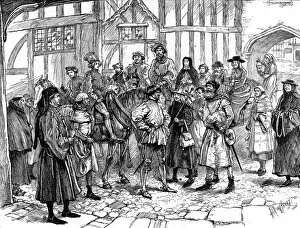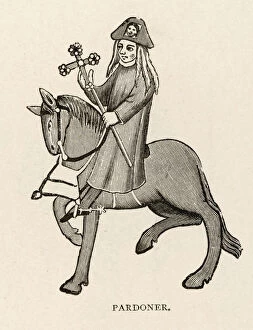Pardoner Collection
"The Pardoner: A Complex Character on Chaucer's Canterbury Pilgrimage" In Geoffrey Chaucer's renowned literary work, The Canterbury Tales
All Professionally Made to Order for Quick Shipping
"The Pardoner: A Complex Character on Chaucer's Canterbury Pilgrimage" In Geoffrey Chaucer's renowned literary work, The Canterbury Tales, a diverse group of pilgrims embarks on a journey from the Tabard Inn to the sacred city of Canterbury. Among them is the enigmatic figure known as the Pardoner. Depicted in various forms throughout history, including colour lithographs and woodcuts, the Pardoner stands out with his distinctive appearance and demeanor. As Mine Host gathers these intriguing characters together, we catch glimpses of the Prioress's innocent smile and witness the Sumpnour's presence alongside our mysterious pardoning figure. The Pardoner plays a significant role in this medieval narrative. Known for selling indulgences to absolve sins, he represents both religious corruption and hypocrisy. His tale within The Canterbury Tales delves into themes of greed and deception while warning against materialistic desires that lead to downfall. Whether portrayed through line engravings or illuminated manuscripts like Ellesmere manuscript, The Pardoner captivates readers with his complex nature. He challenges societal norms by exposing human vices while embodying them himself. Chaucer masterfully crafts this character who serves as a mirror reflecting upon society's flaws during this pilgrimage. Through vivid descriptions and thought-provoking dialogues, The Pardoner becomes an emblematic symbol of moral ambiguity within medieval literature. As we delve deeper into Chaucer's masterpiece, we encounter conflicting emotions towards this controversial character – fascination mixed with repulsion; intrigue intertwined with skepticism. Such is the power of The Pardoner that even centuries later he continues to spark discussions among scholars and enthusiasts alike. So join us on this captivating journey through time as we explore Chaucer’s world – where knights rub shoulders with merchants, where nuns share tales alongside millers – all under the watchful eye of The Pardoner, a figure whose presence lingers long after the final page is turned.














